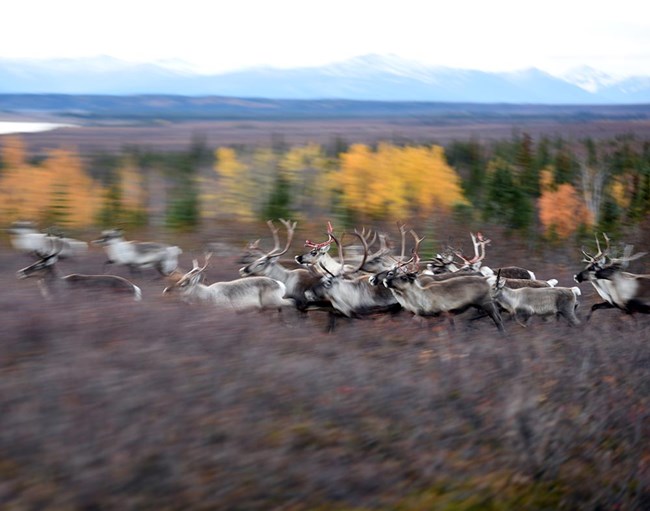Last updated: November 1, 2022
Article
How do caribou decide when to migrate in the fall?

NPS/M CAMERON
Caribou make some of the longest-distance migrations on the planet, yet how they decide when to migrate south in the fall has remained a bit of a mystery. Biologists with the National Park Service worked with colleagues from the University of Alaska Fairbanks to investigate this question for the Western Arctic Herd, Alaska’s largest caribou herd. Using data from GPS-collars fitted to females from 2010-2018, they paired the location data with estimates of weather/environmental conditions (such as temperature and snow depth) and a vegetation metric specific to the caribou's location at specific times. They used a statistical model to relate how a caribou moved (such as a long-distance movement like migration, or a shorter movement like foraging) with the conditions she experienced. They found that, in general, decreasing temperatures and the first snowfall events of the winter were the main signals caribou used to decide when to migrate. One of the most interesting findings was that caribou updated their decision to migrate during the journey based on new conditions. If they moved to an area where temperatures were warmer or snow was absent, they might slow down and spend more time there before moving on when temperatures cooled off and snow fell again. Fall migration timing is generally variable and the study suggests that this is because caribou experience different environmental conditions, since they are spread out at this time of year. Fall migration has become later for this herd across the last three decades and this work suggests that the trend will continue as the climate warms.
Mechanistic movement models identify continuously updated autumn migration cues in Arctic caribou
Abstract
Background
Migrations in temperate systems typically have two migratory phases, spring and autumn, and many migratory ungulates track the pulse of spring vegetation growth during a synchronized spring migration. In contrast, autumn migrations are generally less synchronous and the cues driving them remain understudied. Our goal was to identify the cues that migrants use in deciding when to initiate migration and how this is updated while en route.
Methods
We analyzed autumn migrations of Arctic barren-ground caribou (Rangifer tarandus) as a series of persistent and directional movements and assessed the influence of a suite of environmental factors. We fitted a dynamic-parameter movement model at the individual-level and estimated annual population-level parameters for weather covariates on 389 individual-seasons across 9 years.
Results
Our results revealed strong, consistent effects of decreasing temperature and increasing snow depth on migratory movements, indicating that caribou continuously update their migratory decision based on dynamic environmental conditions. This suggests that individuals pace migration along gradients of these environmental variables. Whereas temperature and snow appeared to be the most consistent cues for migration, we also found interannual variability in the effect of wind, NDVI, and barometric pressure. The dispersed distribution of individuals in autumn resulted in diverse environmental conditions experienced by individual caribou and thus pronounced variability in migratory patterns.
Conclusions
By analyzing autumn migration as a continuous process across the entire migration period, we found that caribou migration was largely related to temperature and snow conditions experienced throughout the journey. This mechanism of pacing autumn migration based on indicators of the approaching winter is analogous to the more widely researched mechanism of spring migration, when many migrants pace migration with a resource wave. Such a similarity in mechanisms highlights the different environmental stimuli to which migrants have adapted their movements throughout their annual cycle. These insights have implications for how long-distance migratory patterns may change as the Arctic climate continues to warm.
Cameron, M. D., J. M. Eisaguirre, G. A. Breed, K. Joly, and K. Kielland. 2021. Mechanistic movement models identify continuously updated autumn migration cues in Arctic caribou. Movement Ecology 9(54): 12 pp.
